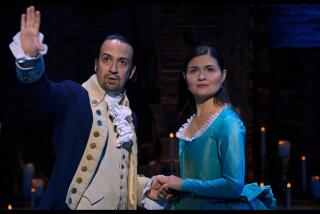Celebrating Fuller to the Fullest, at Last
Samuel Fuller, who liked to direct with a cigar in one hand and sometimes a .45 in the other, received the accolades at a near-three-hour memorial tribute Saturday morning at the Directors Guild that had largely eluded him during his many years in Hollywood.
The intensely personal, well-attended “Farewell Tribute to Samuel Fuller,” hosted by director Curtis Hanson on behalf of the director’s widow, Christa, and their daughter, Samantha, was the very model of its kind and assembled by Hanson with the help of producers Polly Platt and Jon Davison and others. Director of the current “L.A. Confidential” and Fuller’s co-writer on “White Dog,” Hanson expertly selected clips that were interwoven with speakers, all of whom clearly cared for Fuller, who died Oct. 30 at his Hollywood Hills home.
An American Cinematheque retrospective held in celebration of his 86th birthday in August served as a reminder that this feisty master of genre was, after all, one of the Hollywood greats, but most of his honors came from Europe, where until recent years he had lived and worked for about a decade.
Fuller, who combined an often comically tough-guy style with warmth, honesty and generosity, had been a cult figure for nearly 40 years. He was revered by fellow directors, colleagues and critics for his taut, vital and psychologically complex war pictures like “The Steel Helmet” and “Fixed Bayonets,” westerns like “I Shot Jesse James,” “Run of the Arrow” and “Forty Guns” and such films noir as “Pickup on South Street” and “Underworld, U.S.A.” Socially conscious without a trace of preachiness, he attacked racism in such varied films as “The Crimson Kimono,” “Shock Corridor” and “White Dog.”
A graduate of the New York tabloid journalism of the ‘20s and ‘30s and later a pulp novelist, he could put lurid melodrama to such good use and in such an entertaining fashion that he was perhaps too easily dismissed by the more genteel critical sensibilities. Yet few American films are as contemplative as “The Baron of Arizona” (1950), based on a true story of an elegant con man (a memorable Vincent Price) who tried to grab the entire territory.
*
Actress Dolores Dorn, one of the many who spoke at the tribute, theorized that Fuller may simply have been too gritty for his day, attaining career heights in the ‘50s and ‘60s. Most of his films have already stood the test of time, and Dorn predicted that appreciation of them will only increase in the future. (Bernardo Bertolucci sent a message, calling Fuller “the greatest, most important unrecognized American director.”)
“Film is like a battleground,” Fuller stated famously in Jean-Luc Godard’s “Pierrot Le Fou” (1965). “Love, hate, action, violence, death--in one word, emotion.” That philosophy infused his films, which in turn reflected Fuller’s vivid personality. Fuller, who appeared more often in front of the camera than behind it in recent years, was physically a small man with a leonine mane of silver hair and a shrewd gaze, but his presence was so strong you never thought of him as anything but larger than life. He spoke in a rat-a-tat-tat style and sounded like Walter Winchell, and as director Wim Wenders remarked in a message from Tokyo, “he was the greatest storyteller of the 20th century.”
Gene Barry, Robert Stack, Peter Breck, Robert Carradine, Paul Winfield and Nelye Morrow (who appeared in more Fuller films than anyone else) told hilarious, affectionate stories of Fuller’s emphatic style of direction and of his habit of casting actors in an instant, while Dorn, Angie Dickinson and Constance Towers spoke of his more tender tactics with them. Gene Evans got an especially warm ovation; the quintessential Fuller actor, tough but caring, was the star of “The Steel Helmet” (1951) and, most important, of “Park Row” (1952), the director’s stirring paean to the birth of American daily journalism and the freedom of the press.
If Fuller was one of the last links to Hollywood’s Golden Era, he was also one of the last survivors of the “Front Page” period or rip-roaring journalism, becoming a copy boy on Manhattan’s Park Row at age 12. He became legendary editor and columnist Arthur Brisbane’s personal copy boy and at 17 became New York’s youngest crime reporter.
Such fellow directors as Peter Bogdanovich (who credited Fuller with a virtual rewrite of his first feature, “Targets”), Jonathan Demme, Quentin Tarantino, Walter Hill and Paul Mazursky spoke, with Tim Robbins summing up Fuller as “an original who confused an awful lot of people, a true patriot with a love of freedom . . . who challenged others as he challenged himself.”
More to Read
Only good movies
Get the Indie Focus newsletter, Mark Olsen's weekly guide to the world of cinema.
You may occasionally receive promotional content from the Los Angeles Times.










